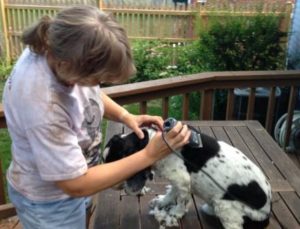The first step is to know your dog. Do daily, or at a minimum weekly, grooming to notice lumps or sensitive areas. Don’t leave this to the groomer every few months!
Once your dog gets used to you grooming him, he will come to enjoy it. I groom my dogs before breakfast, so their reward is eating and of course getting petted and rubbed.
Grooming sessions should include:
- Comb or brush your dog. My dogs have their fur shaved in the summer and I often notice bumps when their fur is short. I can also notice fleas and ticks.
- If you notice any small bumps, check in a few days later to see if it has healed. If not, determine its size and shape and write it down for future reference. Your vet will appreciate this information during your next visit.

Chipper getting shaved.
- If you notice any small bumps, check in a few days later to see if it has healed. If not, determine its size and shape and write it down for future reference. Your vet will appreciate this information during your next visit.
- Brush their teeth—daily if possible. Notice any changes in the odor of their breath and sensitive areas.
- Other grooming should include ear cleaning and periodically trimming their nails.
- Weigh them periodically—at least once a month, weekly is better. I do this by picking up my dog, then standing on my scale. Of course, this may not be practical for large dogs. Perhaps training them to have two paws on different scales may work.
- Record your dog’s weight on a wall calendar to keep track of it. Again, your vet will appreciate this information, and it will let you know if you need to cut back on the treats.
10 warning signs your dog might have cancer
The National Canine Cancer Foundation lists ten signs to watch for and I have added a few comments.
- Abnormal swellings that persist or continue to grow.
- Sores that don’t heal.
- Weight loss.
- Offensive odor.
- All of the above you can notice during routine grooming.
- Loss of appetite.
- Could be due to stomach upset, but if it persists for more than a few days, see your vet.
- Hesitation to exercise or loss of stamina
-
- This could be due to the summer heat, a minor injury or arthritis. But pay attention. Don’t just think your dog is getting old.
- Persistent lameness or stiffness
-
- Notice when your dog limps for more than a day or so and is not improving with crate rest. If the limping persists for more than a week—see your vet.
- Bleeding or discharge from any body opening.
- Difficulty eating or swallowing.
- See your vet as soon as possible for both numbers 8 and 9. Visit the emergency vet if these symptoms are severe.
- Difficulty breathing, urinating, or defecating.
Go to an emergency vet if your dog has difficulty breathing and possibly for urination problems. Your regular vet can help with problems with defecating.

I weigh Mr. N weekly. I taught him how to jump up onto the scale on cue. I also check him over when I pet him and brush his teeth.
Yes, it’s good to weigh your dog weekly and to brush their teeth daily. At least that’s what I do.